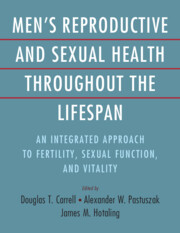 Men's Reproductive and Sexual Health Throughout the Lifespan
Men's Reproductive and Sexual Health Throughout the Lifespan from Section 4 - Laboratory Evaluation and Treatment of Male Infertility
Published online by Cambridge University Press: 06 December 2023
Sperm banking, or male fertility preservation, is widely used prior to medical, surgical, and nonmedical procedures that might affect a male’s fertility. Both federal and state regulations have been instituted to regulate the sperm banking industry, requiring rigorous screening and testing of sperm donors and detailed records of the donors and clients that choose to store their own sperm. Cryopreservation consents are detailed and cover long-term storage, use of the specimens, and disposition of the specimens in case of incapacitation or death of the sperm banker or lack of need for the frozen specimens. Sperm cryopreservation is relatively simple in the laboratory, but does require trained staff working with cryopreservatives and liquid nitrogen. With the increased use of ART, cryopreservation of even the poorest specimens with only a few sperm has become routine. Sperm can be retrieved with testicular biopsy or epididymal aspiration even in the case of purported azoospermia. Use of fresh or frozen specimens have been shown to yield comparable results. The future of sperm cryopreservation is promising as we look to storage of testicular tissue for future autotransplantation as well as prepubertal spermatogonial stem cell storage for future in vitro maturation, or transplantation and growth of testicular tissue and sperm production.
To save this book to your Kindle, first ensure no-reply@cambridge.org is added to your Approved Personal Document E-mail List under your Personal Document Settings on the Manage Your Content and Devices page of your Amazon account. Then enter the ‘name’ part of your Kindle email address below. Find out more about saving to your Kindle.
Note you can select to save to either the @free.kindle.com or @kindle.com variations. ‘@free.kindle.com’ emails are free but can only be saved to your device when it is connected to wi-fi. ‘@kindle.com’ emails can be delivered even when you are not connected to wi-fi, but note that service fees apply.
Find out more about the Kindle Personal Document Service.
To save content items to your account, please confirm that you agree to abide by our usage policies. If this is the first time you use this feature, you will be asked to authorise Cambridge Core to connect with your account. Find out more about saving content to Dropbox.
To save content items to your account, please confirm that you agree to abide by our usage policies. If this is the first time you use this feature, you will be asked to authorise Cambridge Core to connect with your account. Find out more about saving content to Google Drive.